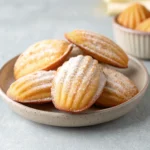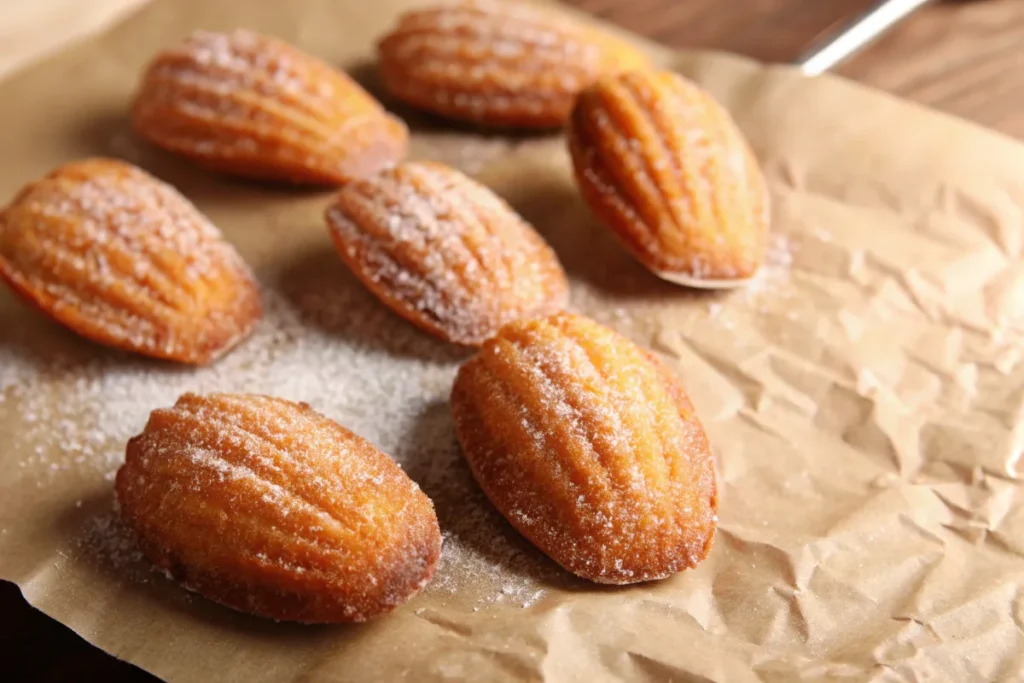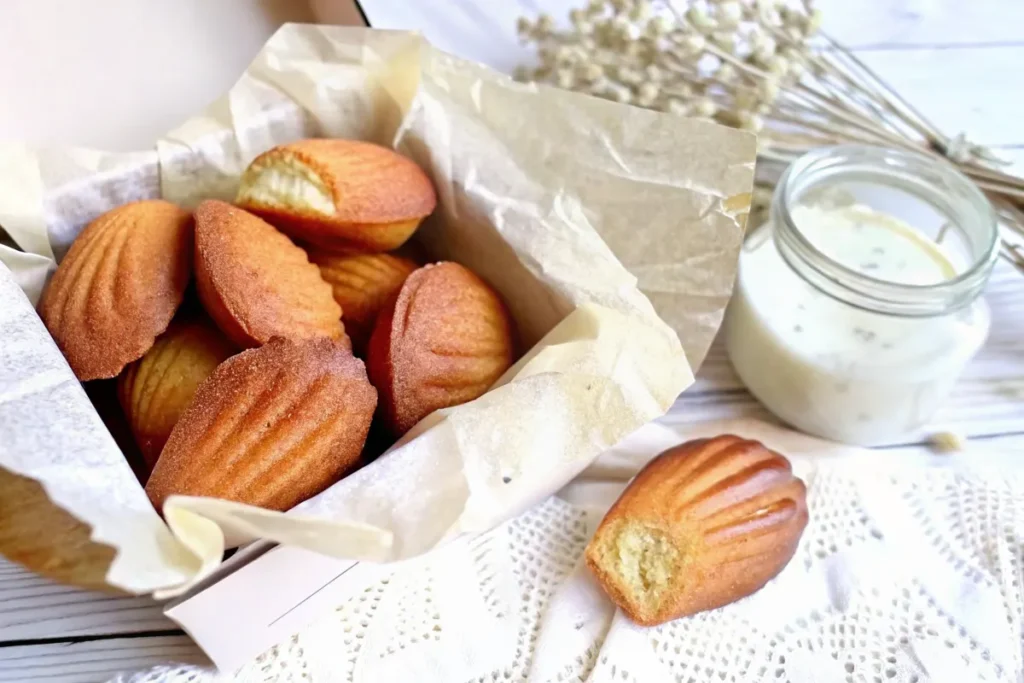Free gluten madeleine recipes have become the go-to option for dessert lovers looking to enjoy a soft, buttery treat without the digestive discomfort gluten can bring. Whether you’re managing celiac disease, gluten sensitivity, or simply exploring healthier alternatives, gluten-free madeleines offer the same delicate texture and signature shell shape as the classic French cookie—minus the wheat. In this guide, we’ll dive deep into what makes a gluten-free madeleine truly irresistible. You’ll discover the best ingredients, techniques, troubleshooting tips, and flavor variations that bring this elegant cookie to life—without sacrificing taste or texture.
Plus, if you’re just starting out in gluten-free baking or looking to perfect your method, we’ll walk you through it all, step-by-step. From understanding the science behind gluten-free flours to mastering the iconic “hump,” this is your one-stop resource for mastering the art of the free gluten madeleine.
Print
Free Gluten Madeleine – The Ultimate Guide for Soft, Flavorful Bites
- Total Time: 27 minutes
- Yield: 12 madeleines 1x
Description
These classic free gluten madeleines are soft, buttery French sponge cookies made without wheat, perfect for those with gluten sensitivities or anyone exploring cleaner baking. With their iconic shell shape and tender, airy crumb, these cookies are every bit as elegant and delicious as the original—just more inclusive. Lightly sweet with a hint of vanilla, they’re ideal for tea time, gifting, or a refined everyday treat.
Ingredients
2 large eggs
1/2 cup (100g) organic cane sugar
1/2 cup (60g) almond flour
1/4 cup (30g) rice flour
2 tbsp (16g) tapioca starch
1/2 tsp baking powder (gluten-free)
1/4 tsp xanthan gum (optional, for structure)
Pinch of salt
1/2 cup (115g) unsalted butter, melted and cooled
1 tsp vanilla extract or 1/2 tsp vanilla bean paste
Zest of 1 lemon (optional)
Powdered sugar, for dusting
Instructions
Prep the pan: Grease your madeleine mold with butter and lightly dust with rice flour. Tap out the excess and set aside.
Whisk eggs and sugar: In a mixing bowl, beat the eggs and cane sugar for 3–5 minutes until pale, thick, and airy.
Add butter and flavor: Gently mix in the melted butter, vanilla, and lemon zest (if using).
Combine dry ingredients: In another bowl, whisk together almond flour, rice flour, tapioca starch, baking powder, xanthan gum (if using), and salt.
Fold it in: Gently fold the dry mixture into the wet batter using a spatula until just combined—do not overmix.
Rest the batter: Cover and refrigerate the batter for at least 30 minutes (or up to overnight) to help achieve the classic madeleine “hump.”
Bake: Preheat oven to 375°F (190°C). Spoon batter into prepared molds, filling each cavity about 3/4 full. Bake for 10–12 minutes or until edges are golden and centers spring back.
Cool and finish: Let cookies rest in the pan for 2–3 minutes before transferring to a wire rack. Dust with powdered sugar before serving.
Notes
Flavor Twist: Add 1 tbsp cocoa powder for a chocolate version, or 1/2 tsp dried lavender for floral notes.
Dairy-Free Option: Use melted coconut oil or vegan butter instead of dairy butter.
Storage: Store in an airtight container for up to 3 days, or freeze for up to 1 month. Reheat in a 275°F oven for 5 minutes to revive the texture.
Pro Tip: Don’t skip the resting step—cold batter and a hot oven are the secrets to the classic madeleine hump!
- Prep Time: 15 minutes
- Cook Time: 12 minutes
- Category: Dessert
- Method: Dessert / Tea Cake
- Cuisine: French
Nutrition
- Serving Size: 2 madeleines
- Calories: ~130 per serving
- Fat: ~8g
- Carbohydrates: ~12g
- Protein: ~2g
What is a Free Gluten Madeleine?
Understanding Gluten-Free Baking
A free gluten madeleine is a delightful twist on the classic French sponge cookie, made without any wheat-based ingredients. Instead of using traditional flour, a free gluten madeleine is crafted using gluten-free flours like almond, rice, or oat, allowing even those with gluten sensitivities or celiac disease to enjoy this elegant treat.
One of the biggest misconceptions about gluten-free baking is that it sacrifices texture or flavor. But when it comes to the free gluten madeleine, nothing could be further from the truth. With the right balance of ingredients and a touch of technique, you can recreate that perfect bite—soft in the center with gently crisped edges.
What’s more, the free gluten madeleine isn’t just for people with dietary restrictions. It’s ideal for anyone seeking clean ingredients or exploring alternative baking methods. These cookies fit seamlessly into modern healthy lifestyles without losing their indulgent charm.
Whether you’re serving them at tea time or packaging them as gifts, the free gluten madeleine is always a showstopper. Its versatility makes it easy to flavor with lemon zest, vanilla, or even lavender, opening up endless possibilities for customization.
Finally, even beginners in gluten-free baking can master a free gluten madeleine. With a little patience and the right mold, you’ll soon be producing bakery-quality cookies that both look and taste amazing.
Check out our collection of delicious madeleine recipes and get inspired:
👉 https://eternalrecipes.com/madeleines-recipes/
Why Choose Gluten-Free Madeleines?
Health Benefits of Going Gluten-Free
Choosing a free gluten madeleine isn’t just about dietary limitations—it’s also about embracing a more mindful way of enjoying dessert. For individuals with celiac disease, even small amounts of gluten can cause serious health problems. Thankfully, gluten-free alternatives make it possible to indulge safely.
But even those without gluten intolerance are jumping on board. A free gluten madeleine can be easier on digestion, especially when made with whole-grain flours like oat or buckwheat, which add both fiber and flavor. It’s also common to find these cookies made with natural sweeteners, which reduces the glycemic impact.
More importantly, a free gluten madeleine opens the door to inclusive baking. Whether you’re hosting a gathering or simply baking for family, you don’t have to worry about leaving anyone out. Gluten-free madeleines ensure everyone can have a bite—without compromise.
Many gluten-free recipes include nutrient-rich ingredients such as chia seeds or flax meal, which add protein and omega-3s. That means your free gluten madeleine might be not only delicious but also packed with subtle health benefits.
With more people moving toward allergen-conscious eating, the demand for the free gluten madeleine has never been higher. It’s now considered a staple in gluten-free dessert menus, loved for its texture, taste, and beautiful presentation.
So whether you’re baking for health, lifestyle, or simple curiosity, the free gluten madeleine is a smart and satisfying choice for every kitchen.

Ingredients for the Perfect Free Gluten Madeleine
Best Gluten-Free Flours for Baking
The secret to a flawless free gluten madeleine starts with selecting the right flour blend. Since we’re eliminating wheat, texture and taste must come from a smart combination of gluten-free alternatives. Almond flour is a top choice—it adds moisture, flavor, and a tender crumb. Rice flour offers lightness, while tapioca starch and potato starch contribute to chewiness and structure.
Some bakers prefer pre-made gluten-free flour blends, which are balanced with binders like xanthan gum. But when crafting a truly perfect free gluten madeleine, customizing your own blend allows for better control over texture. Just remember: a 1:1 substitution with wheat flour rarely works. Always experiment and test until you get that signature sponge-like bite.
Another tip? Sift the flour. Gluten-free flours can clump easily, and sifting ensures your free gluten madeleine batter remains smooth and airy.
Natural Sweeteners and Additives to Use
To sweeten a free gluten madeleine, stick with natural options that won’t overpower the delicate flavor. Organic cane sugar is ideal for its clean taste, while maple syrup or honey can be used in moderation for a richer profile. Avoid overly moist sweeteners like agave—they can weigh down the batter and prevent the madeleine from rising properly.
For added depth, many bakers mix in citrus zest, vanilla extract, or almond essence. These pair perfectly with the slightly nutty base of a free gluten madeleine, creating a balanced flavor that’s not too sweet, not too bland—just right.
Lastly, don’t forget baking powder. It helps the batter rise and contributes to the famous “hump” on top. A good rise makes the difference between an average cookie and a free gluten madeleine worth remembering.
Looking for inspiration? Try this oatmeal cake with apple compote—another gluten-free favorite:
👉 https://eternalrecipes.com/oatmeal-cake-with-apple-compote/
How to Make Free Gluten Madeleines from Scratch
Step-by-Step Baking Instructions
Baking the perfect free gluten madeleine requires care, timing, and a little technique—but don’t worry, we’ve broken it down into simple steps:
- Prepare your pans. Grease your madeleine molds with butter or a dairy-free alternative, then dust lightly with rice flour to prevent sticking.
- Whisk your eggs and sugar. Beat them until the mixture becomes pale and fluffy. This step is crucial for achieving that sponge-like texture every free gluten madeleine needs.
- Add melted butter and flavorings. Use cooled melted butter along with vanilla extract or lemon zest for added aroma.
- Fold in the dry ingredients. Carefully combine your sifted gluten-free flour blend with the wet ingredients. Don’t overmix—gentle folding keeps the batter light.
- Rest the batter. Let it chill in the fridge for at least 30 minutes. This step helps create that classic hump we all love in a free gluten madeleine.
- Bake. Preheat the oven to 375°F (190°C), and bake for 10–12 minutes or until the edges turn golden brown.
- Cool and dust. Let the cookies cool for a few minutes in the pan before transferring them to a rack. Dust lightly with powdered sugar for a touch of elegance.
Remember, the key to an excellent free gluten madeleine lies in balancing the airy interior with a slightly crisp shell. Don’t skip the chilling step—it’s your golden ticket to madeleine greatness.
Common Mistakes and How to Avoid Them
Even seasoned bakers can stumble when making a free gluten madeleine, but knowing what to avoid will set you up for success.
Mistake #1: Overmixing the batter. This adds too much air, leading to deflation or dense cookies. Be gentle.
Mistake #2: Skipping the chilling phase. Without proper rest, your batter won’t rise properly in the oven, and your free gluten madeleine may turn out flat.
Mistake #3: Using the wrong flour blend. Not all gluten-free flours are created equal. Stick with a tested mix or follow the tips in Part 3.
Mistake #4: Underbaking. These cookies should have golden edges and a springy center. Underbaking leaves them gummy instead of spongy.
By avoiding these pitfalls, you’ll elevate your free gluten madeleine game and impress even the pickiest dessert lover.
Don’t miss our healthy chia strawberry treat—a light and fruity snack to pair with madeleines:
👉 https://eternalrecipes.com/healthy-chia-strawberry-treat/
Top Gluten-Free Madeleine Recipes to Try
Classic Vanilla Perfection
There’s something timeless about the aroma of vanilla wafting through your kitchen. A classic vanilla version offers the simplest way to experience the beauty of gluten-free madeleines. Using a mix of almond flour and tapioca starch, these treats come out tender with just the right bounce.
To enhance flavor, consider infusing your batter with vanilla bean paste instead of extract. It gives a richer, deeper vanilla note and a charming speckled look to the finished cookie. A sprinkle of powdered sugar at the end seals the deal—simple, elegant, and delicious.
Creative Flavor Variations: Lemon, Chocolate & More
Ready to push your baking skills further? Flavor variations are where these petite sponge cookies truly shine. Here are a few ideas to try:
- Lemon Zest & Poppy Seed: Add fresh lemon zest and a teaspoon of poppy seeds for a refreshing citrus twist.
- Double Chocolate Delight: Mix in cocoa powder and mini dark chocolate chips for a rich, dessert-like bite.
- Lavender Honey: Infuse your butter with dried lavender buds and add a touch of honey for a floral, delicate profile.
- Pumpkin Spice: Perfect for fall—use canned pumpkin, cinnamon, nutmeg, and clove for a cozy seasonal treat.
These versions are all adaptable and crowd-pleasing. For even more inspiration, discover great ideas like these flavor variations:
👉 https://eternalrecipes.com/5-flavor-variations-for-homemade-madeleines/
Gluten-Free Madeleine Baking Tips from Experts
Getting the Signature Madeleine Hump
That iconic hump on top isn’t just for looks—it’s a sign of perfect baking technique. Achieving it consistently comes down to a few core tips:
- Chill the batter. Resting it for 30 minutes (or up to overnight) firms up the fat and allows the baking powder to activate slowly. This contrast of cold batter hitting a hot oven causes the batter to “shock” and rise rapidly.
- Preheat your oven properly. Use an oven thermometer to make sure it hits a steady 375°F (190°C).
- Use metal molds. Silicone pans don’t conduct heat as effectively. Metal molds help form a crisp edge and encourage a more dramatic rise.
These small details lead to professional-level results—even for home bakers.
Storage, Freezing, and Reheating Tips
Gluten-free baked goods often have a shorter shelf life, but these cookies can last beautifully with the right storage method:
- Room Temperature: Store in an airtight container for up to 3 days.
- Freezing: Place them in a single layer on a baking sheet to freeze individually, then transfer to a freezer bag. They’ll stay fresh for up to a month.
- Reheating: Bring to room temperature or warm gently in a low oven (around 275°F) for 5 minutes. This revives the outer crispness while maintaining the tender interior.
Planning ahead? Bake a large batch, freeze half, and enjoy a fresh batch anytime you like. That’s the magic of strategic baking.

Don’t miss our detailed guide on getting the signature madeleine hump just right:
👉 https://eternalrecipes.com/secrets-to-getting-the-signature-madeleine-hump/
Troubleshooting Gluten-Free Madeleines
Why Your Madeleines Might Be Dry or Flat
Baking without gluten can sometimes feel like walking a tightrope. If your madeleines are coming out dry, crumbly, or flat, don’t worry—these common issues have simple fixes.
Dry Texture? You may have used too much flour or baked them a few minutes too long. Try reducing the flour slightly or checking for doneness a minute earlier next time. Also, make sure your flour blend includes a moisture-retaining starch like tapioca or arrowroot.
Flat Tops Instead of the Signature Hump? This often happens when the batter isn’t chilled long enough or when the oven isn’t hot enough. Always preheat your oven and let the batter rest at least 30 minutes before baking. That initial cold-to-hot shock is what forms the perfect dome.
Crumbly Cookies? This could mean not enough binding agents were used. A teaspoon of xanthan gum or psyllium husk powder can help mimic the elasticity that gluten normally provides.
Baking gluten-free treats can be trial and error, but once you identify the weak spots, adjusting your recipe becomes second nature.
Fixing Texture and Taste Issues Without Gluten
Getting the texture just right is often the trickiest part of gluten-free baking. Madeleines should be light and airy on the inside with just a slight crisp on the edges.
To enhance structure, try adding extra egg yolks—they bring richness and improve mouthfeel. A dash of apple cider vinegar or lemon juice can activate baking soda and improve lift.
As for taste, gluten-free flours often benefit from bold flavors. Incorporate zests, extracts, or spices to round out the flavor profile. Whether you prefer nutty, citrusy, or floral notes, enhancing these elements will give your cookies the richness they deserve.
Still not happy with the result? Experiment in small batches until you find the perfect balance.
Don’t miss our banana pancakes recipe—another gluten-free breakfast treat with satisfying texture:
👉 https://eternalrecipes.com/banana-pancakes-recipe/
Serving and Pairing Gluten-Free Madeleines
Ideal Beverages and Dips
Madeleines may be petite, but they pair like a pro. Their delicate texture and subtly sweet flavor make them the perfect companion for drinks and dips that elevate the overall experience.
Tea Pairings: Earl Grey or chamomile complement the soft sponge-like texture beautifully. For a bolder experience, try chai or matcha tea.
Coffee Choices: A fresh espresso or cappuccino adds contrast and balances the sweetness. You can also try a flavored latte like hazelnut or vanilla.
Dips & Drizzles:
- Dark chocolate ganache
- Honey-lavender glaze
- Berry compote or puree
These accompaniments can turn a simple cookie into an elegant plated dessert.
Whether you’re hosting brunch or preparing a dessert platter, thoughtful pairing makes all the difference.
Occasions and Presentation Ideas
These cookies shine at more than just teatime. They’re an ideal addition to a variety of occasions—from baby showers to office parties.
Elegant Occasions: Stack them on a tiered serving tray and garnish with edible flowers or mint leaves.
Holiday Events: Dip them halfway in chocolate and decorate with crushed peppermint or festive sprinkles.
Everyday Treat: Wrap a few in parchment paper with twine for a rustic, charming snack on the go.
Presentation isn’t just about looks—it enhances the sensory experience. Whether you serve them fresh from the oven or jazzed up with toppings, these soft sponge cookies always make a statement.
Explore even more healthy dessert options in our ultimate chocolate cake recipe:
👉 https://eternalrecipes.com/ultimate-chocolate-cake-recipe/
Free Gluten Madeleine Alternatives and Substitutes
Vegan and Dairy-Free Madeleine Variations
For those avoiding animal products, a variety of alternatives can be used to create delicious, plant-based versions of this French classic. The goal is to retain the soft, tender crumb without using eggs or butter.
Egg Substitutes:
- Flaxseed or chia seed gel (1 tbsp seeds + 3 tbsp water per egg)
- Unsweetened applesauce
- Commercial egg replacers (like Ener-G or Bob’s Red Mill)
Butter Substitutes:
- Coconut oil for richness and moisture
- Vegan butter for a more traditional taste
- Neutral oils like avocado or sunflower
These swaps work beautifully in most recipes, creating a vegan cookie that’s just as flavorful and elegant.
Nut-Free, Sugar-Free, and Keto Options
Have other dietary needs? No problem—gluten-free madeleines are incredibly adaptable. If you’re avoiding nuts, swap almond flour for a combination of oat flour and rice flour. If you’re watching sugar intake, natural sweeteners like stevia, monk fruit, or erythritol can keep things sweet without spiking your blood sugar.
For keto versions, combine coconut flour, almond flour, and erythritol while increasing egg content to help maintain structure. It takes a bit of trial and error, but the result is a low-carb treat that’s still soft and satisfying.
These alternative recipes prove that no matter your dietary goals, there’s a way to enjoy this classic cookie.
Try this vegan strawberry chia delight for more plant-based dessert ideas:
👉 https://eternalrecipes.com/vegan-strawberry-chia-delight/
FAQ Section
Could wasps be able to manage gluten-free pancakes?
As curious as it sounds, no—wasps can’t manage or cook anything. This question may stem from a playful misunderstanding. Cooking requires human skills, and while wasps are fascinating insects, they’re not built for the kitchen.
Is he the best manager for madeleines?
That depends! Managing a great batch of madeleines means understanding baking science, precision with timing, and knowledge of ingredients—especially in gluten-free recipes. If “he” has those skills, then yes, he could be.
What type of flour do you make from madeleines?
Trick question! You don’t make flour from madeleines—you make madeleines with flour. In gluten-free versions, common choices include almond flour, rice flour, or gluten-free flour blends designed for pastry baking.
Conclusion
Whether you’re baking for health reasons or exploring new culinary territory, the free gluten madeleine delivers elegance, flavor, and comfort in every bite. This guide has taken you from understanding the origins and ingredients to perfecting your baking technique and expanding your flavor horizons.
With so many variations—vegan, nut-free, keto, and beyond—this soft sponge cookie fits nearly any dietary lifestyle. By embracing thoughtful ingredients and expert techniques, you can enjoy a free gluten madeleine that’s as indulgent as it is inclusive.
Looking for more creative ways to treat yourself? Don’t miss our recipe for the most irresistible healthy chocolate cake:
👉 https://eternalrecipes.com/ultimate-chocolate-cake-recipe/
